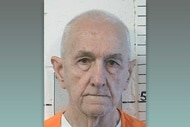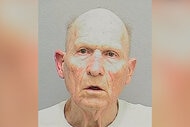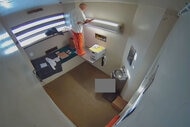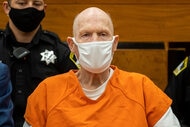Create a free profile to get unlimited access to exclusive videos, breaking news, sweepstakes, and more!
Why Is Golden State Killer Suspect Joseph DeAngelo In A Cage In Court Appearances? How Could It Affect His Trial?
Several legal experts didn’t even know there was a cage in a courtroom anywhere in America.
He stood in a cage with metal bars. A sign on it warned others in the courtroom not to talk to the man inside.
Joseph DeAngelo, the 72-year-old Golden State Killer suspect, peered through the bars while locked up inside a Sacramento courtroom last month. It was the second time since his arrest in April that the accused serial killer appeared in court in a cage, resembling Hannibal Lecter in "The Silence of the Lambs."
It's a stunning image that, some experts say, could subliminally sway the entire case.
“We just saw something that we've only seen in the movies, which is why it's so tough to wrap one's head around it,” Lance Reenstierna, co-host of two popular true crime podcasts (Missing Maura Murray and Crawlspace), told Oxygen.com. “What is inevitable and unfortunate is that the cage elevates him to a legend status as a serial killer.”
It turns out DeAngelo, who has been charged with murdering 12 people across California in the 1970s and 1980s and is accused of raping more than 50 women, isn't behind those bars for any particular reason. They are just a feature of the courtroom used for pre-trial hearings. It is expected that DeAngelo will not be in the cage or in visible shackles during his trial.
“The cage is a permanent fixture in all of our jail courtrooms,” Kim Pedersen, public information officer for the Superior Court of California, County of Sacramento told Oxygen.com. “They are used each and every day for our in custody defendants.”
It's unclear how many other courts have this arrangement, but it's certainly rare. Spokespeople for the San Diego and the San Francisco County court systems confirmed that they do not use physical barriers in any courtrooms.
The practice is so uncommon that several legal experts didn’t even know there was a cage in a courtroom anywhere in America.
“It’s extremely unusual, as far as I know, for U.S. courtrooms to have cage in which defendants are placed,” Darryl Brown, a criminal law professor at the University of Virginia School of Law, told Oxygen.com. He had only heard of one other case in the country in which someone was caged in a courtroom.
Once a trial begins, defendants have a constitutional right to appear before juries without visible restraints, according to Brown. He said that restraints, and certainly a cage, would make defendents look dangerous and guilty.
That's why the early images of a frail-looking DeAngelo behind bars could change his trial.
Researchers have determined that pre-trial publicity in a major case sways jurors. A 1999 study in Law and Human Behavior stated that jurors exposed to negative news coverage about a defendent were more likely to convict that defendent. A 2009 study published in Psychology, Law & Crime states that pre-trial publicity "has a powerful effect on jury verdicts and that PTP [pre-trial publicity] exposure can influence the interpretation and discussion of trial evidence during deliberations."
A 2015 Huffington Post op ed explains: "Some argue that searching questions of jurors can cure pre-trial publicity. If you believe that I have a bridge to sell you. Many jurors lie to get on juries, and many lie to stay off juries. Sometimes jurors maintain they have heard no publicity about a case only to remember later that they had heard damaging information about the defendant."
In at least one case, the Supreme Court ruled that news coverage tainted the Sixth Amendment right to a fair trial. Doctor Sam Sheppard was convicted of killing his wife in 1954 but his conviction was overturned in 1966 by the Supreme Court, which said news coverage influenced the jurors' decisions. Before he was charged with any crime, local media ran scandalous first-page stories which pointed the finger at him as the suspect. A woman went on a radio show claiming to be Sheppard's mistress and the mother of his illegitimate child. Two of the jurors, whom were not yet even sequestered, told the judge they heard that radio broadcast. They weren't dismissed from the case. Critics of the media called the media response to the killing a "carnival atmosphere" and that was long before 24-hour news coverage and the internet.
Although uncommon in the United States, court cages are often used abroad, especially in Eastern Europe and Central Asia.
Soviet serial killer Andrei Chikatilo, who has been convicted of 52 murders between 1978 and 1990, appeared caged in a Russian courtroom in 1992. Chikatilo, nicknamed the Butcher of Rostov and the Red Ripper, was put in an iron cage so that he wouldn’t attack the families of victims.
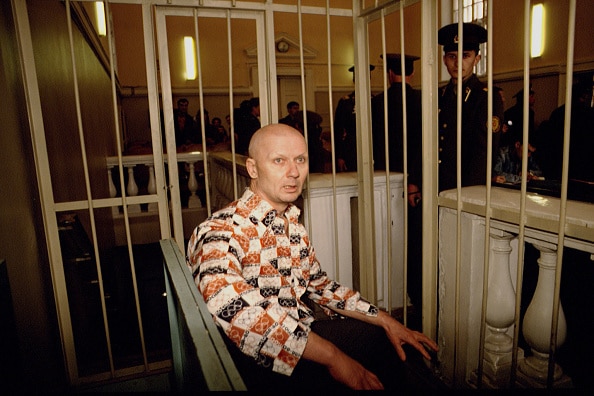
Former Egyptian president Mohamed Morsi was put in a mesh metal cage during his 2013 trial. He was 83 years old at the time.
In Western European countries, including Spain, Italy, France and Germany, cages are sometimes used for particularly violent criminals. But the European Court of Human Rights limits and criticizes their use, according to Brown. In England and Australia, defendants are often put in a dock, a section in the back of a courtroom which separates itself from the rest of the room with either a half-wall or a shield of glass. It's usually only for terrorism cases or if there are security concerns.
This photo of a dock was taken in France.
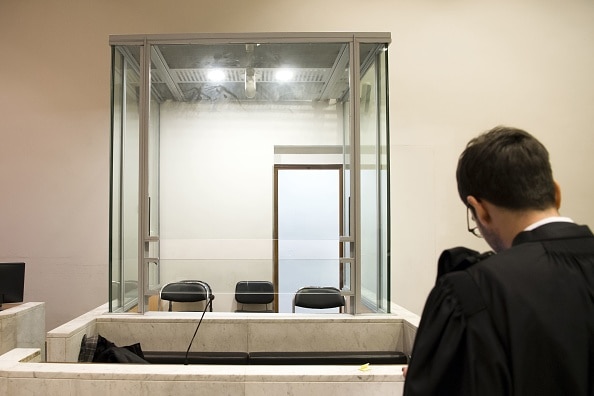
The images of DeAngelo in a cage could not only affect the jury, but how the general public views him.
Reenstierna said the cage could only dehumanize DeAngelo, a side effect he says would be warranted.
“He spent decades destroying hundreds and thousands of lives,” Reenstierna said. “He dehumanized and reduced his victims to mere things so f--- him. Put him in a cage, broadcast it, and if that image resonates and helps put him away for good then I'm all for it.”
But others think the cage may have already done damage to the case.
"I think it'd be very difficult for a jury to not be impacted by seeing him locked in a cage like that," Tim Pilleri, who co-hosts true crime podcasts alongside Reenstierna, said. "But I'm sure they can find people who haven't read much or done their homework on him like we true crime followers have."
DeAngelo's attorneys not have not returned Oxygen.com's requests for comment.
[Photos: Getty Images]





